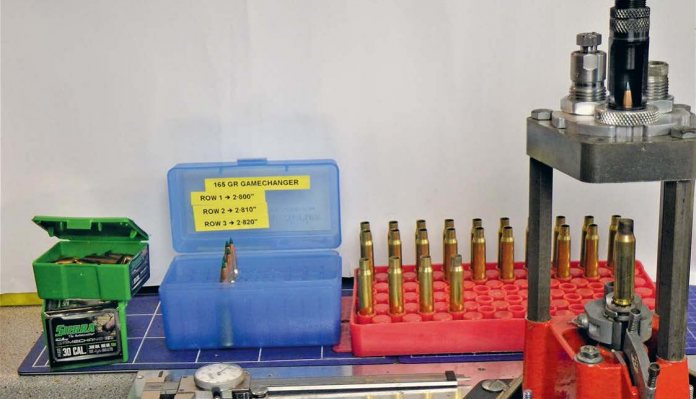Reloading - Bullet Seating Depth
-
1
 Comments
Comments
- Last updated: 26/01/2022

Once you have been reloading for a while you will come to realise just how much control you have over the different elements of your completed ammunition. You can change primer and case brand, weight and type of powder charge and even the bullet type and weight. All of these will affect the accuracy of your loads. Having so much choice gives you huge scope to ‘experiment’ with components and their effect on accuracy, but you can also make changes to how you put together what you use. bullet seating depth is one such parameter that you can experiment with and the impact on your group size can be significant.
The barrel of every gun has its own set of harmonics and it will react uniquely to any particular ammunition. In practice, this means that a load recommended to you, maybe by someone who says it is the ‘best load’for your calibre, just will not perform in your gun. There is probably nothing wrong with the load, it just doesn’t suit your rifle, and this is where experimenting with bullet seating depth might help bring the load into the ‘sweet spot’ for your own gun. You will already appreciate the effect that a small change in powder charge, maybe just ½ a grain, can have on accuracy and fine-tuning with different seating depths can be just as effective.
The SAAMI recommended Cartridge Overall Length (COL) is a maximum figure and is defined as ‘the greatest dimension of a loaded cartridge’. It is intended as a guide to the optimum dimension to fit, and function safely in, the defined chamber dimensions for the given calibre. In practice, the COL can be longer or shorter than the SAAMI figure and reloading data will normally include a recommended cartridge length for each specific load. This is because different bullets vary in length and therefore affect the COL. The figure in the reloading data is the more specific and suitable figure to use with your chosen bullet.
A few words of caution. Firstly, decreasing the COL reduces the available space within the case, which has the effect of increasing chamber pressure, so you cannot reduce the length too much without risking exceeding the maximum chamber pressure for your gun. Secondly, if you increase the cartridge overall length too much, you risk the bullet hitting the lands of your rifle barrel, which then resist the bullet leaving the chamber and cause increased chamber pressure. For these reasons, changes to the cartridge length must only be small. If the length is increased without reaching the lands, then there is more space inside the case and this reduces chamber pressure and, as a consequence, muzzle velocity.
In order to test the effects of changing the seating depth, and therefore the cartridge overall length, make 5 rounds using your selected reloading data and the SAAMI recommended COL for that load. Then, make up further batches of 5 rounds, each with the COL increased by increments of 0.01”. For example, 2.800”, 2.810”, 2.820” 2.830”. Each time you adjust the seating die, first make up a dummy round, with no primer and no powder, and try it in the gun to check that you are not hitting the lands in the barrel. If the round does not chamber easily, or if there are marks on the bullet where it has hit the lands, stop and back down the COL until there are no marks and the round chambers without any resistance. The increments are only very small but they will still effect chamber pressure, velocity and group size. Everything apart from the COL should be kept the same, including any crimp you are applying to the completed rounds.
When you test-fire the rounds, shoot them in the order shortest to longest, starting at the SAAMI recommended length and keeping an eye out for any signs of dangerous pressure.
Shoot each batch of five rounds and record the group size. If you have a chronograph, then measure the changes in velocity as well. You should expect the cartridges with a longer COL to give lower velocities but the actual changes may only be very small.
Just exactly how the different rounds perform in your gun cannot be predicted, but you should expect a change in group size as you fire each batch. In my own tests with my .308 Win, the initial increase in COL caused the group size to open up considerably, but then it came back down and settled at a more acceptable and respectable 2”. In your own tests, the group size can go either way and you might find that the SAAMI COL is actually the optimum length for your gun after all.
When experimenting with parameters like bullet seating depth, all kinds of results can occur in different rifles. Guns are very ‘individual’ and finding the cartridge overall length that suits your own particular gun can take a long time. You might also try different bullet weights and types in the process and they will all have their own ‘optimum’ COL. Reloading is an endless search for the best load for your particular gun, having its own sweet spot when it comes to bullet seating depth, when accuracy is at its best.
If you give it a try with your rifle, you must always put safety first and keep an eye out for signs of excessive pressure. I have deliberately avoided suggesting reducing the COL below the recommended figure, due to potential safety issues, as this is best left to experienced reloaders. Stay within the safe limits when it comes to the overall length of your rounds and you are sure to be rewarded with improved accuracy
